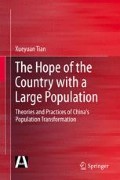Abstract
The sustainable development is generally proposed or explained as a development strategy or international program of action. Is there a theoretical basis for the development strategy or the program of action? If there is, what is the theoretical foundation and system? Many scholars have discussed this problem in the recent two or three decades, particularly the most recent decade, and proposed different points of view including the environmental determinism, population-oriented theory, and the growth mode transformation-centered theory. However, due to limited quantity and depth, these researches are only considered as the basis for empirical study. The study on the theory of sustainable development lags behind the practical situation and is required to deepen.
Access this chapter
Tax calculation will be finalised at checkout
Purchases are for personal use only
Notes
- 1.
Data source: China Statistical Yearbook 1994, China Statistical Publishing House, 1994, P59 and P345.
- 2.
Domestic and foreign estimations on China’s surplus agricultural labors vary from 100 to 200 million. China Agenda 21 estimates it as more than 100 million, which will reach about 200 million by 2000.
- 3.
Data source: China Statistical Yearbook 1994, P26.
- 4.
Refer to Tian Xueyuan [17]. The formula is \( C=\frac{U{y}_1+H{y}_2+M{y}_3+L{y}_4+I{y}_5}{U+H+M+L+I} \). U, H, M, L, and I here respectively refer to the population having received education of university, high school, middle school, illiterate, and semi-illiterate, while y 1, y 2, y 3, y 4, and y 5 respectively refer to the educational years they have received, which are respectively 16, 11, 8, 4, and 0.25 year in this formula.
- 5.
Data source: United Nations [14].
- 6.
Data source: “The Population and Employment of China in 2000”, Collectives of Tian Xueyuan, China Economic Publishing House, 1991, P285–286.
- 7.
Data source: “Data on the Sampled Investigation on the Elderly Population Aged Above 60 in China in 1987”, Chinese Journal of Population Sciences, supplementary issue (1), 1988, P264–267.
References
(1993). The 1992 United Nations Conference on Environment and Development in Rio de Janeiro, Agenda 21 (State Environmental Protection Administration, Trans.). China Environmental Science Press.
(1994). Agenda for 21st century – White paper on population, environment and development. China Environmental Science Press.
Chen Yaobang. (1996). On the strategies of sustainable development. Beijing, China: China Planning Press.
(1994). The administrative center for China’s agenda 21. On China’s sustainable development. China Ocean Press.
Zhang Weiqing. (1997). Population problem – The core of China’s sustainable development. Chinese Journal of Population Sciences (1st issue).
Tian Xueyuan. (1997). Difficulties of the power – Population problem of Modern China. Beijing: China Today Press.
(1995). Collections of Tian Xueyuan (Vol. 2). China Economic Publishing House.
United Nations. (1995). Program of action at the international conference on population and development, Cairo 1994 (Population and Development, Vol. 1).
United Nations. (1994). Population environment and development. New York: United Nations.
Schultz, T. W. (1990). On the investment on human capitals (Wu Zhuhua et al., Trans.). Beijing, China: Beijing Economic College Press.
Naisbitt, N. (1984). Overall trend – Ten new orientations that will change our life (Mei Yan, Trans.). Beijing, China: China Social Sciences Publishing House.
Bell, D. (1986). Approach of the post-industrial society (Wang Hongzhou, Trans.). Commercial Press.
Kuznets, S. (1989). Modern economic growth. Beijing, China: Beijing Economic College Press.
United Nations. (1993). World population prospects the 1992 revision. New York: United Nations.
Xia Fei. (1998, August 28). How to permanently control the floods of Yangtze River. Kuangming Daily.
Jin Huiwen. (1998, August 27). Collection of the top 100 disasters of China in the 20th century. Digest News.
Tian Xueyuan. (1988). Data on the sampled investigation on the elderly population aged above 60 in China in 1987. Chinese Journal of Population Sciences, supplementary issue (1).
Author information
Authors and Affiliations
Rights and permissions
Copyright information
© 2014 Social Sciences Academic Press (China) and Springer-Verlag Berlin Heidelberg
About this chapter
Cite this chapter
Tian, X. (2014). Population and Sustainable Development. In: The Hope of the Country with a Large Population. Springer, Berlin, Heidelberg. https://doi.org/10.1007/978-3-642-40832-8_5
Download citation
DOI: https://doi.org/10.1007/978-3-642-40832-8_5
Published:
Publisher Name: Springer, Berlin, Heidelberg
Print ISBN: 978-3-642-40831-1
Online ISBN: 978-3-642-40832-8
eBook Packages: Humanities, Social Sciences and LawSocial Sciences (R0)

